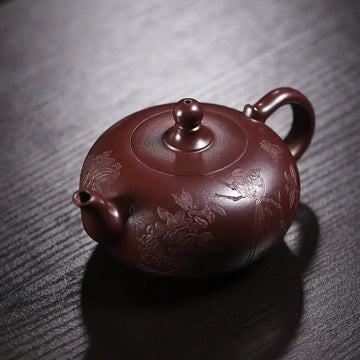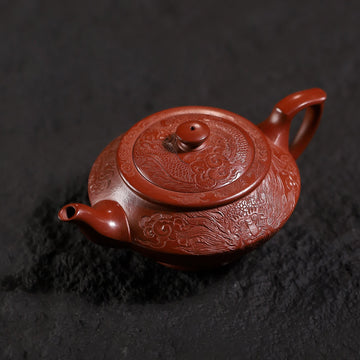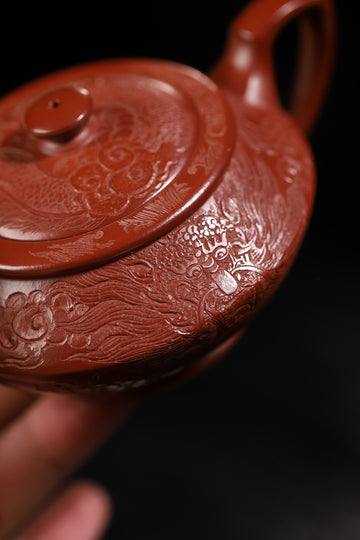Floral Engraving Fully Handmade Dragon Blood Sand-Zini Clay 'Phoenix Pearl' Yixing Teapot
-
Estimated Delivery:Oct 29 - Nov 02
-
Free Shipping & Returns: On all orders

Floral Engraving Fully Handmade Dragon Blood Sand-Zini Clay 'Phoenix Pearl' Yixing Teapot
Floral Engraving Fully Handmade Dragon Blood Sand-Zini Clay 'Phoenix Pearl' Yixing Teapot
1. Material & Craftsmanship
Fully handmade with rare Dragon Blood Sand-Zini clay blend, exhibiting a deep reddish-brown hue and jade-like smoothness. Features exquisite low-relief engraving with intricate patterns. Perfect lid fit demonstrates masterful craftsmanship.
2. Design
The 'Phoenix Pearl' shape boasts a full, rounded body with well-proportioned short spout and curved handle. Front side engraved with floral-bird-butterfly motifs, back side inscribed with classical poetry. Paired with white porcelain cup (red patterns), wooden tea tools and blue antique book.
3. Symbolism
Camellias represent nobility and resilience; butterflies symbolize freedom and transformation. The poem depicts camellias blooming proudly in frost, conveying perseverance through adversity. Embodies the literati's tea meditation philosophy.
4. Usage Experience
225ml ideal capacity for 2-3 people. Excellent heat retention enhances Pu'er and aged white tea brewing. Smooth water flow and clean pouring make for exceptional user experience.
5. Scene & Value
Dark wood setting with fern leaves and antique books creates an Eastern aesthetic space. Serves as both daily teaware and collectible art piece, perfect for tea ceremonies, cultural gatherings, or as premium gift.
Yixing Teapot Crafting Process
Seven steps of traditional craftsmanship passed down for centuries

Material Selection
Selecting the finest purple clay from Huanglong Mountain. Ore undergoes natural weathering and manual screening to ensure high purity and plasticity.
- Ore depth ≥5 meters
- 3-stage screening
- 72 hours weathering
- Clay purity >98%

Clay Refining
Traditional stone grinding techniques transform raw clay into workable material. The process ensures optimal plasticity for shaping.
- 12 hours grinding
- Manual pounding
- 48 hours sedimentation
- Precise moisture control

Hand Shaping
Artisans use paddle forming methods to create the teapot body. Continuous work ensures uniform thickness and smooth lines.
- Precise paddlings
- Thickness ≤0.5mm
- Unique fingerprint
- Spout/handle alignment

Intricate Carving
Master craftsmen carve patterns into the teapot surface. Each stroke reflects artistic vision and technical skill.
- Hand-carved details
- Traditional motifs
- Uniform 0.3mm depth
- Custom designs

Natural Drying
Teapots dry in controlled environments to prevent warping or cracking. Temperature and humidity are precisely maintained.
- 25±2℃ temperature
- 60±5% humidity
- 48-hour period
- Regular rotation

Traditional Firing
Traditional kilns fire teapots at 1180°C±10°C for 12 hours. Pine wood firing imparts unique mineral effects.
- Precise temperature
- 12-hour duration
- 48-hour cooling
- Pine wood effects

Fine Polishing
Artisans hand-polish teapots using natural materials. The process enhances luster and creates a protective layer.
- 3-stage process
- Natural beeswax
- Gloss inspection
- Quality control
Teapot Seasoning and Maintenance

1. Seasoning Method
1. Cleaning
Remove any dust or impurities from inside and outside the teapot and its components. Rinse the teapot thoroughly with hot water to warm it up.
2. Initial Brewing
Brew your preferred tea in the pot and pour the tea liquor over the exterior. When the temperature is high, the subtle pores of the teapot expand slightly, allowing moisture to appear on the surface. Gently wipe the body with a tea maintenance cloth while it is still warm. Repeat this entire process at least three times. Note: The tea brewed during this step is not suitable for drinking.
3. Drying
After several rounds of brewing, the “fire energy” (raw kiln feel) of the teapot will be largely reduced. Rinse the pot with clean water and let it air dry completely. It is then ready for daily use.
Tip:
If a strong chemical odor is detected after boiling or if the color of the pot fades, it may indicate a chemically dyed teapot. This method can help identify authentic Zisha clay.
2. Maintenance Principles
-
Before brewing, moisten the outside of the pot with warm water before adding water inside—a practice known as “rinsing the pot.”
-
After use, wipe the exterior with a soft cloth to keep it dry. Avoid leaving tea liquid inside to prevent residue buildup, which may affect the pot’s appearance.
-
Allow the teapot to “rest” for 3–5 days after a period of use, ensuring it dries thoroughly.
-
Keep the pot away from oily or dusty environments to maintain the porous structure of the clay.
-
Follow the “one teapot for one type of tea” rule to prevent cross-flavoring.
-
Never use detergents or chemical cleaners, as they can damage the natural luster of the teapot.
Shipping cost is based on weight. Just add products to your cart and use the Shipping Calculator to see the shipping price.
We want you to be 100% satisfied with your purchase. Items can be returned or exchanged within 30 days of delivery.
Recently Viewed Products

































